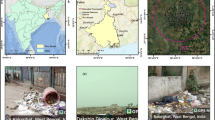Abstract
Successful implementation of integrated water resources planning and management (IWRM) requires delineation of regions that are relatively homogeneous with respect to multiple criteria, including hydrographic, physical-environmental, socioeconomic, and political-administrative aspects. The water resources planning and management (WARPLAM) DSS is presented as tool for regionalization in support of IWRM through: (1) GIS processing of spatial data related to multiple criteria for defining the homogeneity of clustered base units (e.g., catchments) with respect to multiple criteria; (2) application of fuzzy set theory to development of composite measures of homogeneity over all criteria for alternative clustering of adjacent base units; and (3) development of a modified dynamic programming clustering algorithm that guarantees consistent optimal solutions based on user preferences on the relative importance of the suite of criteria considered for regionalization. The viability of WARPLAM DSS as a tool for regional delineation in support of IWRM is demonstrated through a case study application to the Tocantins-Araguaia River Basin, the second largest in Brazil.











Similar content being viewed by others
References
Allan JA (2005) Water in the environment/socio-economic development discourse: sustainability, changing management paradigms and policy responses in a global system. Government and opposition. Blackwell Publishing, Oxford
Allende TC, Mendoza ME, Lopez-Granados E, Morales-Manilla L (2009) Hydrogeographical regionalization: an approach for evaluating the effects of land cover change in watersheds. A case study in the Cuitzeo Lake Watershed, Central Mexico. Water Resources Management 23:2587–2603
ANA (2009) Plano Estratégico de Recursos Hídricos da Bacia Hídrográfica dos Rios Tocantins e Araguaia: Relatório Síntese. Brasília: Agência Nacional de Águas, Ministério do Meio Ambiente
Bellman R (1973) A note on cluster analysis and dynamic programming. Math Biosci 18:311–312
Coelho AC (2010) Multicriteria decision support system to delineate water resources planning and management regions. PhD Dissertation. Colorado State University, Fort Collins
Coelho AC, Gontijo WC, Cardoso A (2005) Unidades de planejamento e gestão de recursos hídricos: Uma proposta metodológica. In: Anais 7o Simpósio de Hidráulica e Recursos Hídricos dos Países de Língua Oficial Portuguesa, Silusba, Portugal
Esogbue AO (1986) Optimal clustering of fuzzy data via fuzzy dynamic programming. Fuzzy Set Syst 18:283–298
Everitt BS, Landau S, Leese M (2001) Cluster analysis. Oxford University Press, New York
Global Water Partnership (2000) Towards water security: a framework for action. Stockholm, Sweden
Haunert JH, Wolff A (2010) Area aggregation in map generalisation by mixed-integer programming. Int J Geogr Inf Sci 24(12):1871–1897
Kaufman L, Rousseeuw PJ (1990) Finding groups in data: an introduction to cluster analysis. John Wiley & Sons, New York
Labadie JW (2003) Generalized dynamic programming package: CSUDP: documentation and user guide, Version 2.44. Department of Civil Engineering, Colorado State University, Fort Collins
Lee J-H, Labadie JW (2007) Stochastic optimization of multireservoir systems via reinforcement learning. Water Resources Research 43(W11408)
Maulik U, Bandyopadhyay S (1999) Genetic algorithm-based clustering technique. Pattern Recogn 33:1455–1465
Mostert E, Craps M, Pahl-Wostl C (2008) Social learning: the key to integrated water resources management? Water Int 33(3):293–304
Wiering M, Verwijmeren J, Lulofs K (2010) Experiences in regional cross border co-operation in river management. Comparing three case studies at the Dutch-German border. Water Resour Manag 24:2647–2672
Xu R, Wunsch D (2009) Clustering. IEEE Press, Piscataway
Acknowledgements
The authors would like to thank the Fulbright International Educational Exchange Program of the U.S. Department of State, the Brazilian National Water Agency, and the Brazilian Agency for Improvement of Higher Education Personnel (CAPES) for their financial support through grant 2276/05-4 of the first author in her research program leading to development of WARPLAM DSS.
Author information
Authors and Affiliations
Corresponding author
Rights and permissions
About this article
Cite this article
Coelho, A.C., Labadie, J.W. & Fontane, D.G. Multicriteria Decision Support System for Regionalization of Integrated Water Resources Management. Water Resour Manage 26, 1325–1346 (2012). https://doi.org/10.1007/s11269-011-9961-4
Received:
Accepted:
Published:
Issue Date:
DOI: https://doi.org/10.1007/s11269-011-9961-4




